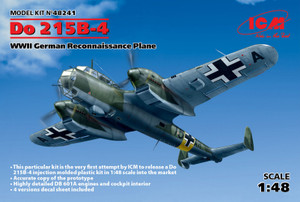
ICM # 48101 1/48 Mistel S1 German composite training aircraft
Manufacturer ICM
Product code icm48101
Weight: 0.82 kg
Ean: 4823044408481
Scale 1:48
Added to catalog on: 17.2.2022
Tags: ME-109 Junkers-88
Junkers Ju-88 is a German, twin-engine, multi-role aircraft in the spine-wing configuration, with a classic tail and all-metal structure. The flight of the prototype took place on December 21, 1936, and the entry into service took place in 1939. The first production series was powered by Jumo 211A engines. Thanks to good flight characteristics, considerable performance and a solid construction on the basis of the Ju-88, several different versions of the aircraft have been created, performing various functions. The first mass-produced version is the Ju-88A, with many revisions. It served as a medium bomber. Its three revisions have been adapted to desert operations (A9, A10, and A11). Ju-88B planes, which were used as reconnaissance aircraft, were produced on a small scale. On the other hand, the Ju-88C was produced on a large scale, with BMW 801 engines, which was a great night fighter. The Ju-88-C6c version featured the SN-2 radar and the Schrage Musik cannons. The D version is another reconnaissance version, but with new engines. Another development model is the famous Ju-88G, which is a night fighter with more and more modern aircraft radars (SN2, SN3, FuG-218, and finally the FuG-240 centimeter radar in the Ju-88G-7C version) and more powerful versions of engines. In addition, the following versions were created: Ju-88H, Ju-88p, Ju-88S and Ju-88T. The plane was used during the September Campaign, the War in Western Europe and the Battle of Britain in 1940, on a large scale on the Eastern Front and in battles with the Allied bombing raids over the German skies. About 15,000 copies of this successful aircraft were built, all versions. Technical data (Ju-88G): length: 15.5 m, wingspan: 20.08 m, height: 5.07 m, maximum speed: 550 km / h, maximum range: 2500 km, maximum ceiling 9900 m, armament: permanent-4 MG151 cannons / 20 20mm machine guns, 1-2 MG131 13mm machine guns and 1-2 MG151 / 20 20mm cannons in the Schrage Musik system.The Messerschmitt Bf-109 is a German metal-structure single-engine fighter in a low wing configuration with a classic tail. It turned out to be the basic and most produced Luftwaffe fighter during World War II. The flight of the prototype took place on May 29, 1935, and serial production continued in the years 1936-1945. In total, it is estimated that a total of about 35,000 Messerschmitt Bf-109 fighters of all varieties were produced, many of which ended up in the Czech and Israeli air forces after the war. The roots of the Bf-109 go back to the competition announced in 1933 by the Luftwaffe for a new fighter plane. In competition with the He-112, the Bf-109 project initially lost, but thanks to Willie Messerschmitt's intrigues, the project could continue and eventually he was the winner of the competition, becoming the Luftwaffe's primary fighter. Several main variants of the Bf-109 were developed in the course of production. The first pre-production series was the Bf-109B (Berta) with different versions of the Junkers Jumo 210 (A or Da) engine. They were tested in Spain from 1937 during the Civil War. The next version is the Bf-109C (Caesar). They had a different engine than the B version, and extensive armament consisting of two 20mm and 2 HP 7.92mm cannons. These machines also fought in the skies of Spain. The third version is the Bf-109D (Dora) with the Junkers Jumo 210 Da or Daimler-Benz DB 600 engine. It fought in the September campaign, but at the turn of 1939/1940 it was replaced by the E version. The most famous model was the Bf-109E (Emil) with a Daimler-Benz 601A or N engine. It was the first to use a three-blade, not a two-blade propeller. Bf-109E fought in the French campaign, over England, and in North Africa and on the Eastern Front. The ace who started his career on the Bf-109E was the famous Adolf Galland. The next version is the Bf-109F (Friedrich), which, according to the German pilots, was the most aerodynamically perfect. It sowed the changed shape of the fuselage, wings, cabin fairings, but no new engine was used. It was put into service at the turn of 1940/1941. As part of the development of the design, further Bf-109 specifications were developed, of which the G (Gustav) version was produced in the largest number of copies. The most important change increasing the machine's performance was the installation of a new 12-cylinder Daimler-Benz DB605A engine with 1475HP. The armament of the Bf-109G was a pair of 13mm machine guns located in the fuselage in front of the cockpit fairing, and the MG151 20mm or heavier MK108 30mm cannon. The last mass-produced version was the Bf-109K (Kurfirst), which production started in October 1944. A Daimler-Benz DB 605DB or DC unit was used as the engine. The Bf-109K was the fastest version produced during World War II, reaching up to 730 km / h. Apart from that, two versions were created - H and Z, but they were rather experimental versions and their mass production did not start. Subsequent improvements in propulsion and armament made the Messerschmitt Bf-109 one of the most dangerous fighters of World War II, and at the same time showed the great potential of the slightly angular airframe created by Willi Messerschmitt. Technical data (version Bf-109 G-6): length: 8.95 m, wingspan: 9.92 m, height: 2.6 m, maximum speed: 640 km / h, rate of climb: 17 m / s, maximum range: 850 km, maximum ceiling 12000m, armament: fixed - 2 MG131 13mm machine guns and 1 MG151 20mm cannon, suspended - 250 kg bombs, or 2 Wfr missile launchers. Gr. 21